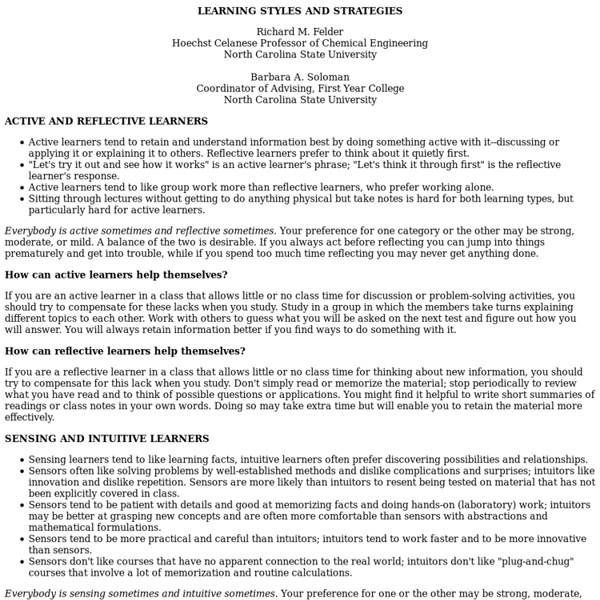Overview of learning styles
Many people recognize that each person prefers different learning styles and techniques. Learning styles group common ways that people learn. Everyone has a mix of learning styles. Some people may find that they have a dominant style of learning, with far less use of the other styles.
What Is Your Learning Style?
What Is Your Learning Style? This quiz asks 24 questions and will take less than five minutes to complete. Try not to think too hard -- just go with your first thought when describing your daily activities and interests. By the end, you may have some new insights into your learning preferences. Editor's Note (2013): There is no scientific evidence, as of yet, that shows that people have specific, fixed learning styles or discrete intelligences, nor that students benefit when teachers target instruction to a specific learning style or intelligence.
Sleep learning is possible: Associations formed when asleep remained intact when awake
Is sleep learning possible? A new Weizmann Institute study appearing August 26 in Nature Neuroscience has found that if certain odors are presented after tones during sleep, people will start sniffing when they hear the tones alone -- even when no odor is present -- both during sleep and, later, when awake. In other words, people can learn new information while they sleep, and this can unconsciously modify their waking behavior. Sleep-learning experiments are notoriously difficult to conduct. For one thing, one must be sure that the subjects are actually asleep and stay that way during the "lessons." The most rigorous trials of verbal sleep learning have failed to show any new knowledge taking root.
Creativity Lab – Making in School
Fun fact: here at the Creativity Lab, Making isn’t just about making things. Making is also about learning to see the world with new eyes, and developing deeper knowledge and understanding of the world around us. One of the ways we incorporate this idea is through using Agency by Design’s thinking routines.
What’s the best child care money can buy?
Lisa Larson-Walker This story is part of a series on 2-year-olds produced by the Hechinger Report and the Teacher Project, nonprofit news organizations focused on education coverage, in partnership with Slate magazine. One morning in May, an almost 2-year-old with dark-blond hair named Marin arrived at “school” around 8:30 a.m., a shiny unicorn-shaped backpack on her tiny shoulders. She wore the disgruntled expression of someone whose morning had gotten off to a bad start. In Marin’s case, that was because of an “accident” she had had on the way to school—an accident that now meant changing out of one of her favorite pairs of pants into leopard-print leggings she didn’t like nearly so well.
Journal of Educational Controversy - Article: Developing Dispositions for Ambitious Teaching
Developing Dispositions for Ambitious Teaching David Carroll Western Washington University Critics of teacher education in recent years have argued that attempts to assess dispositions for teaching amount to a process of political indoctrination, claiming that teacher candidates are often expected to endorse ideas like “white privilege” and “social justice” as a kind of political litmus test for entering the teaching profession. In some circumstances, teacher education programs have avoided this kind of controversy by limiting their attention to dispositions such as honesty, integrity, and professional interactions. Charges and counter charges about the potential political implications of dispositions, and lack of clarity about other dimensions of dispositions, have obscured fundamental associations between personal beliefs and professional ethics, and between dispositions and ambitious conceptions of teaching. Role orientation is also the underpinning of professional practice.
45 Design Thinking Resources For Educators
45 Design Thinking Resources For Educators Imagine a world where digital learning platforms help adult learners succeed through college completion; where a network of schools offers international-quality education, affordable tuition, and serves hundreds of thousands of children in economically disadvantaged countries; where we engage parents in understanding national trends and topics in education; where a comprehensive learning environment seamlessly connects the classroom with the opportunities of the digital world for young students; and where system-level solutions help more students gain access to college. Educators across the world have been using design thinking to create such a world. Design thinking consists of four key elements: Defining the Problem, Creating and Considering Multiple Options, Refining Selected Directions, and Executing the Best Plan of Action. An early example of design thinking would have been Edison’s invention of the light bulb.
What Is Differentiated Instruction?
Click the "References" link above to hide these references. Csikszentmihalyi, M. (1997). Finding Flow: The Psychology of Engagement with Everyday Life. New York: Basic Books. Danielson, C. (1996). Enhancing Professional Practice: A Framework for Teaching.
A Design and Innovation Consulting Firm
8 Strategies Robert Marzano & John Hattie Agree On
Robert Marzano and John Hattie have both reviewed research into what teaching strategies make the biggest difference to students’ results. While they used different methods and terminology, they agreed on these 8 powerful strategies. Strategy 1: A Clear Focus for the Lesson
Promoting an Activist Teacher Identity
What does it mean to be a professional teacher? What is the work of professional teachers? How do we construct our understandings of teacher professionalism? These are all questions I explore with pre-service teachers in my undergraduate teaching – most just two or three years removed from being high-school students themselves. They find navigating the complexities of their transitioning teacher identity an arduous task.



